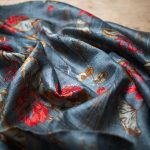Are you curious if you can sublimate on linen fabric? Look no further. This article will provide you with all the information you need to understand the sublimation process on linen fabric.
Discover the best techniques and tips for successful sublimation, as well as how to troubleshoot common issues.
Learn how to choose the right linen fabric and properly care for your sublimated creations.
Get ready to unleash your creativity on linen fabric like never before.
Table of Contents
Understanding Linen Fabric
Linen fabric is a breathable and lightweight material that you can easily sublimate on. Linen is made from the fibers of the flax plant, which gives it unique properties that make it suitable for sublimation printing.
One of the key properties of linen fabric is its breathability. It allows air to flow through the fabric, keeping you cool and comfortable, especially in hot and humid climates. Additionally, linen has excellent moisture-wicking properties, which means it can absorb and release moisture quickly, keeping you dry.
Sublimating on linen has several benefits. Firstly, linen fabric has a natural and rustic texture that adds a unique and organic feel to the sublimated design. The colors appear vibrant and crisp, giving a high-quality finish to the printed image. Secondly, linen is a durable fabric that can withstand repeated washes without fading or losing its shape. The sublimated design becomes a permanent part of the fabric, ensuring longevity. Lastly, linen is a sustainable and eco-friendly choice as it is biodegradable and requires less water and energy to produce compared to other fabrics.
Exploring the Sublimation Process
To explore the sublimation process on a fabric, start by understanding the temperatures and times required for successful results. When it comes to sublimating on fabric, the sublimation temperature plays a crucial role.
Sublimation occurs when a solid substance, such as sublimation ink, transforms directly into a gas without passing through the liquid phase. For sublimation to take place, the fabric needs to reach a specific temperature known as the sublimation temperature. This temperature is usually around 375°F (190°C) for most sublimation inks. However, it is important to note that different types of fabrics may require different temperatures for successful sublimation.
In addition to the sublimation temperature, it is also important to consider the sublimation ink compatibility with the fabric. Not all fabrics are suitable for sublimation, and certain fabrics may require special treatment or coatings to ensure proper ink absorption and color vibrancy. Linen fabric, for example, can be a challenging fabric to sublimate on due to its natural texture and composition. It is recommended to use a sublimation ink specifically formulated for linen fabric and follow the manufacturer’s instructions regarding temperature and time settings.
Choosing the Right Linen for Sublimation
When it comes to sublimating on linen fabric, it’s important to consider the compatibility of the material. Not all linen fabrics are suitable for sublimation, so it’s crucial to choose the right type that will yield the best results.
Understanding the proper sublimation techniques to use on linen can help ensure successful and vibrant prints.
Linen Sublimation Compatibility
Yes, you can use sublimation on linen fabric. Understanding the sublimation process is essential when it comes to sublimating on different fabrics, including linen.
Sublimation is a dyeing technique that involves transferring ink from a solid to a gas state, which then binds to the fabric’s fibers. Linen, known for its natural fibers, can be a suitable material for sublimation.
However, it is important to note that the success of sublimation on linen depends on various factors, such as the fabric’s weave, content, and finish. Linen fabrics with a higher polyester content tend to yield better results as polyester works well with sublimation inks.
It is recommended to test a small sample before proceeding with large-scale sublimation on linen fabrics to ensure optimal results.
Best Linen for Sublimation
For optimal sublimation results, consider using linen fabrics with a higher polyester content as they tend to yield better outcomes. The polyester content in the fabric allows the sublimation ink to fully penetrate the fibers, resulting in vibrant and long-lasting prints.
When sublimating on linen fabric, it is important to pre-treat the fabric with a sublimation coating or spray to enhance the ink absorption. This helps to prevent any ink bleed or fading during the sublimation process.
Additionally, using a heat press at the recommended temperature and pressure settings is crucial to ensure proper ink transfer onto the fabric. It is also advisable to use high-quality sublimation ink and paper for best results.
Taking these tips into consideration will help you achieve excellent sublimation results on linen fabric.
Sublimation Techniques on Linen
To achieve the best sublimation results on linen, it’s important to pre-treat the fabric with a sublimation coating or spray. This step ensures that the ink will penetrate the fibers of the linen fabric and create a durable and vibrant design.
Sublimation on linen offers several advantages, including its durability. Linen is known for its strength and longevity, making it an ideal fabric for sublimation. The sublimated designs on linen will not fade or crack easily, ensuring that your creations will last.
Additionally, sublimation on linen allows for high-quality, detailed prints with vibrant colors. The natural texture and weave of linen enhance the overall look and feel of the sublimated designs, providing a unique and sophisticated result.
Preparing Linen Fabric for Sublimation
Have you considered prewashing the linen fabric before sublimating on it? Prewashing is an important step in preparing linen fabric for sublimation. By prewashing the fabric, you can remove any sizing or chemicals that may be present, ensuring a clean and smooth surface for the sublimation process.
Linen fabric is known for its natural properties, such as its breathability, moisture-wicking ability, and durability. These properties make it a popular choice for sublimation printing. However, linen fabric requires specific temperature and time settings for successful sublimation.
To help you understand the sublimation temperature and time requirements for linen fabric, here is a table outlining the recommended settings:
| Temperature (°C) | Time (seconds) |
|---|---|
| 190 | 60 |
| 200 | 50 |
| 210 | 40 |
| 220 | 30 |
| 230 | 20 |
It’s important to note that these settings may vary depending on the specific type and brand of sublimation ink you are using. Always refer to the manufacturer’s instructions for the best results.
Sublimation Techniques on Linen Fabric
Now that you have prepared your linen fabric for sublimation, it’s time to explore some sublimation techniques specifically for linen. Sublimating on linen fabric can produce beautiful and vibrant designs, but there are a few tips to keep in mind to ensure successful results.
Here are some helpful linen sublimation techniques and tips:
-
Preheat the fabric: Before applying the transfer paper, preheat the linen fabric for a few seconds to remove any moisture and wrinkles, ensuring a smooth surface for sublimation.
-
Use a high-quality transfer paper: Invest in a high-quality sublimation transfer paper that is specifically designed for linen fabric. This will ensure that the ink transfers effectively and retains its vibrancy.
-
Apply firm pressure: When using a heat press, apply firm and even pressure to the fabric. This will help the ink penetrate the fibers of the linen fabric, resulting in a vibrant and long-lasting print.
Tips and Tricks for Successful Sublimation on Linen
When it comes to sublimating on linen fabric, it’s important to consider the fabric’s suitability for the process. Before sublimating, it’s crucial to properly prepare the linen fabric to enhance the quality and longevity of the final print.
To achieve the best results, it’s recommended to follow certain best practices when sublimating on linen. This includes using the appropriate temperature and pressure settings, and ensuring proper ink saturation.
Linen Fabric Suitability
Linen fabric is not suitable for sublimation printing. Despite its many desirable properties, such as its durability, breathability, and natural texture, linen does not possess the necessary properties for successful sublimation printing. Here are a few reasons why:
- Linen has a rough and textured surface, which can cause the sublimation ink to not adhere properly, resulting in a blurry or faded image.
- Linen has a high absorbency rate, which means it absorbs the sublimation ink quickly, leading to less vibrant colors and reduced image clarity.
- Linen has a low melting point, which can cause the fabric to scorch or burn when exposed to the high temperatures required for sublimation printing.
While linen may not be suitable for sublimation printing, there are many other fabrics that are ideal for this process.
Preparing Linen for Sublimation
To properly prepare linen for sublimation, it’s important to preheat the fabric and use a suitable sublimation transfer paper.
Linen fabric is known for its natural fibers and breathability, making it a popular choice for clothing and home decor items. However, sublimation printing on linen requires some specific steps to ensure the best results.
First, preheat your heat press to the recommended sublimation temperature, usually around 380°F (193°C). This helps to remove any moisture and wrinkles from the fabric, ensuring a smooth surface for the transfer.
Next, choose a sublimation transfer paper that is compatible with linen fabric. Look for papers that are specifically designed for sublimation printing and have good ink absorption properties. This will help to ensure vibrant and long-lasting colors on your linen items.
Remember to follow the instructions provided by the sublimation transfer paper manufacturer for best results.
Best Practices for Sublimating Linen
Now that you have prepared your linen fabric for sublimation, it’s time to explore the best practices for sublimating linen. By following these techniques, you can achieve vibrant and long-lasting results on your linen products.
Here are some key tips for sublimating linen fabrics:
-
Use a high-quality sublimation ink: To ensure good color transfer and saturation, invest in a reputable sublimation ink specifically designed for linen fabrics.
-
Opt for a higher temperature and longer dwell time: Linen requires slightly higher temperatures and longer dwell times compared to other fabrics. Experiment with different settings to find the optimal combination for your desired results.
-
Conduct test prints and wash tests: Before sublimating your final design, it’s essential to conduct test prints and wash tests to ensure colorfastness and durability.
Troubleshooting Common Issues With Sublimating on Linen
If you’re experiencing any issues while sublimating on linen, try adjusting the temperature and pressure settings. Linen sublimation challenges can arise due to the unique properties of the fabric, but with proper troubleshooting, you can achieve great results. Here are some common issues and their possible solutions:
| Issue | Possible Solution |
|---|---|
| Uneven color transfer | Increase pressure or temperature to ensure proper dye penetration. |
| Faded or washed-out colors | Decrease temperature or reduce dwell time to prevent overexposure. |
| Blurred or distorted image | Check the alignment of the transfer paper and fabric, ensuring a tight fit. |
It’s important to note that linen is a natural fiber with a tendency to shrink, so pre-shrinking the fabric can help avoid any potential issues. Additionally, make sure to use high-quality sublimation inks and transfer paper specifically designed for linen. Testing different combinations of temperature, pressure, and dwell time is key to finding the optimal settings for your linen sublimation projects. By troubleshooting linen sublimation issues and making the necessary adjustments, you can achieve vibrant and long-lasting sublimated designs on linen fabric.
Caring for Sublimated Linen Fabric
Proper care of sublimated linen ensures the longevity and vibrancy of the colors. Sublimation on linen fabric offers various benefits, such as durability, breathability, and versatility.
Durability: Sublimated linen is resistant to fading, peeling, and cracking, making it ideal for long-lasting designs.
Breathability: Linen is a natural fabric that allows air to circulate, keeping you cool and comfortable.
Versatility: Sublimation allows for vibrant, full-color designs on linen, giving you endless possibilities for customization.
To care for your sublimated linen fabric, follow these simple steps:
-
Wash with care: Machine wash your linen items using a gentle cycle and cold water. Avoid using harsh detergents or bleach to prevent damage to the colors.
-
Dry flat: After washing, reshape your linen items and lay them flat to dry. Avoid wringing or twisting the fabric to maintain its original shape.
-
Iron with caution: If necessary, iron your sublimated linen on a low heat setting, preferably with a cloth or pressing cloth between the iron and the fabric. This will help protect the colors from direct heat.
Conclusion
In conclusion, sublimating on linen fabric is possible and can result in beautiful and vibrant designs. Understanding the characteristics of linen and the sublimation process is key to achieving successful results.
By choosing the right linen fabric and properly preparing it for sublimation, you can ensure a smooth and flawless transfer. Additionally, following some tips and tricks and troubleshooting common issues can help you overcome any challenges that may arise.
Lastly, proper care and maintenance of sublimated linen fabric will ensure its longevity and durability.
- Will 100% Cotton Percale Wrinkle? The Honest Truth - July 15, 2025
- Why Do Toenails Tear Percale Sheets and How to Prevent It - July 15, 2025
- Why Is Percale Considered a Superior Sheet? - July 15, 2025






